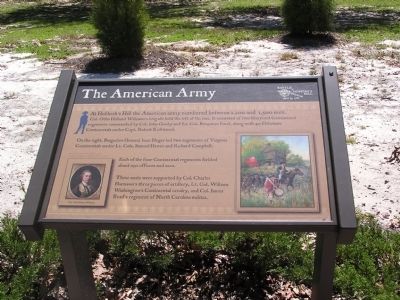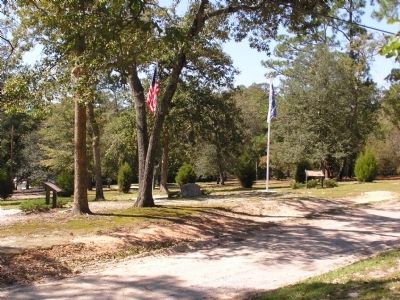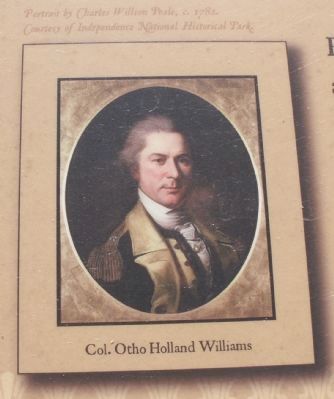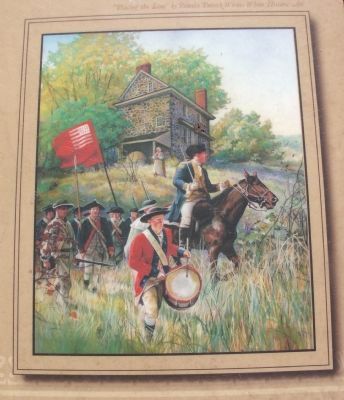Camden in Kershaw County, South Carolina — The American South (South Atlantic)
The American Army
On the right, Brigadier General Isaac Huger led two regiments of Virginia Continentals under Lt. Cols. Samuel Hawes and Richard Campbell.
Each of the four Continental regiments fielded about 250 officers and men.
These units were supported by Col. Charles Harrison’s three pieces of artillery, Lt. Col. William Washington’s Continental cavalry, and Col. James Read’s regiment of North Carolina militia.
Topics. This historical marker is listed in this topic list: War, US Revolutionary.
Location. 34° 16.008′ N, 80° 36.07′ W. Marker is in Camden, South Carolina, in Kershaw County. Marker is on Kirkwood Lane, on the right when traveling east. Touch for map. Marker is in this post office area: Camden SC 29020, United States of America. Touch for directions.
Other nearby markers. At least 8 other markers are within walking distance of this marker. The Battle of Hobkirk Hill (a few steps from this marker); The British Army (a few steps from this marker); Capt. Robert Kirkwood (1756-1791) (about 300 feet away, measured in a direct line); Battle of Hobkirk's Hill (about 300 feet away); A Daring Plan (approx. ¼ mile away); The British Attack (approx. ¼ mile away); Fruitless Victory (approx. ¼ mile away); Struggle for the Hill (approx. ¼ mile away). Touch for a list and map of all markers in Camden.
Additional commentary.
1. Colonel Otho Holland Williams
Otho Holland Williams (March 1, 1749 – July 15, 1794) was a Continental Army officer from Maryland in the American Revolutionary War. He participated in many battles throughout the war in the New York, New Jersey and Southern theaters, eventually ending his career as a Brigadier General.
Born in rural Prince George's County, Maryland, Williams spent his childhood on Springfield Farm near present day Williamsport. He was orphaned at age thirteen and was put in the care of his father's brother-in-law, Mr. Ross. Williams took an apprenticeship under Mr. Ross and studied his profession in the Clerk's office of Frederick, eventually taking charge of the office. At age eighteen, Williams moved to Baltimore and undertook a similar trade. Williams returned to Frederick in 1774 and entered into a commercial life.
In response to Congress's call for soldiers at the outbreak of the American Revolutionary War in the spring of 1775, Williams joined a Continental Army rifle unit as a commissioned officer. Soon thereafter, he and his unit marched off to the Siege of Boston. Seeing his first significant combat action in late 1776 at the Battle of Fort Washington, Williams was captured by the British and imprisoned in New York. He was released in early 1778 and returned to the Continental Army as colonel of the 6th Maryland Regiment, a position he had acquired during his captivity. From thereafter, Williams led his regiment through much of the southern campaign, most notably in the battles of Camden, Guilford Court House, and Eutaw Springs. Near the end of the War, Williams was sent by his commanding officer General Greene with documents to congress and was promoted to brigadier general in 1782.
After the war, Williams later served as an associate justice for Baltimore County, and as the first commissioner of the Port of Baltimore. He returned to Springfield Farm in 1787, bought the house and the surrounding land, and began laying out the town of Williamsport. In 1792, Washington offered Williams to be Brigadier General of the Army, though he declined due to his failing health. Williams
died two years later in 1794 while travelling to Sweet Springs, Virginia.
— Submitted October 13, 2011, by Anna Inbody of Columbia, South Carolina.
Credits. This page was last revised on June 16, 2016. It was originally submitted on October 13, 2011, by Anna Inbody of Columbia, South Carolina. This page has been viewed 683 times since then and 16 times this year. Photos: 1, 2, 3, 4. submitted on October 13, 2011, by Anna Inbody of Columbia, South Carolina. • Craig Swain was the editor who published this page.



